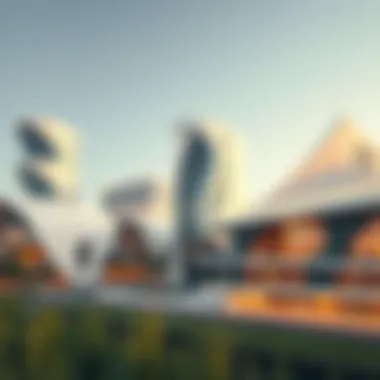Exploring the Dubai 2040 Urban Master Plan


Intro
The Dubai 2040 Urban Master Plan represents a bold vision for the future of one of the world's most dynamic cities. As Dubai navigates the challenges of population growth and technological advancement, this plan aims to address various urban issues, positioning the city to thrive in the coming decades. The focus is not just on enhancing infrastructure but on fostering sustainable living, integrating the latest technologies, and promoting economic diversification.
The excitement around this plan lies in its comprehensive approach. It promises to reshape the urban landscape by prioritizing livability while ensuring that environmental stewardship is woven into the fabric of urban development. Investors, homebuyers, and stakeholders should take a close look at the implications of this plan, as it will undoubtedly influence the real estate market and urban design in profound ways.
Market Trends and Insights
Understanding the context of the Dubai real estate landscape is paramount for potential investors and stakeholders.
Current Market Analysis
Presently, Dubai's real estate market is a patchwork of opportunities and challenges. High-end properties in areas like Palm Jumeirah and Dubai Marina command premium prices, drawing wealthy individuals and expats eager to invest in luxury living. On the other hand, the demand for more affordable housing is steadily rising, especially among younger professionals and families looking for budget-friendly options without compromising quality.
Some valuable insights include:
- The total area available for development is expanding, facilitated by new infrastructure projects.
- There is a growing inclination towards sustainable housing solutions, with eco-friendly designs becoming increasingly preferred among buyers.
- Government initiatives also enhance the market's appeal, with policies designed to stimulate foreign investment and encourage local entrepreneurship.
Historical Trends and Future Predictions
When peering into the crystal ball, one can see a substantial evolution in Dubai's urban landscape over the next two decades. Historically, the real estate market has faced ups and downs, but it largely rebounds and adapts to global economic shifts. For example:
- In the wake of the COVID-19 pandemic, many industries pivoted towards technology, influencing the types of properties in demand. Homes equipped with smart technology and flexible spaces are gaining traction.
- Predictions based on current data suggest that demand for communal living spaces will rise. This trend aligns with the city’s focus on creating vibrant and interconnected communities as per the 2040 vision.
"As we modernize, we must hold onto our core identity while embracing innovation." – A quote reflecting the ethos of the Dubai 2040 Urban Master Plan.
In summary, understanding these market trends is essential for anyone wanting to invest in Dubai's real estate scene. The interplay of luxury and affordability, powered by governmental support, paints a promising picture for future developments.
While the city gears up for the challenges ahead, understanding the implications of the Dubai 2040 Urban Master Plan will provide investors and stakeholders with the insights needed to navigate this transforming landscape.
Prolusion to the Dubai Urban Master Plan
The Dubai 2040 Urban Master Plan is not just a blueprint; it's a guiding light for the future of one of the fastest-growing cities in the world. This plan outlines a strategic approach to urban development aimed at enhancing livability, economic vitality, and sustainability. In today’s globalized world, understanding this plan is essential for stakeholders including investors, realtors, homebuyers, developers, and analysts. They can gain insights into how the city's landscape is poised to shift and adapt to evolving needs.
Central to this plan is its vision for a balanced urban environment that integrates nature, technology, and society. The emphasis on sustainability is not merely a trend; it's a necessity in the face of climate change and escalating urbanization. Access to green spaces, improved public transport, and mixed-use developments are just some of the vital components that reimagined cities across the globe are implementing. With the Dubai 2040 Master Plan, the city aims to secure its position as a leading global hub while caring for the environment and its residents.
As we delve into the particulars of this plan, it becomes clear that the benefits extend far beyond aesthetics or convenience. It addresses core societal issues—from housing shortages to transport inefficiencies—while creating opportunities for businesses to thrive.
Aside from direct advantages like economic growth and increased property values, it targets broader societal outcomes such as social cohesion and cultural preservation. This lays the groundwork for a community that thrives on diversity and collaboration.
"The future depends on what you do today." – Mahatma Gandhi
This sentiment rings true for the Dubai 2040 Urban Master Plan, where the decisions made today will shape the city's tomorrow, influencing every facet of life for its residents. Thus, understanding the historical context and goals behind this initiative becomes imperative for anyone looking to navigate the evolving landscape of Dubai.
Historical Context of Urban Development in Dubai
Dubai's urban development has a storied history that mirrors its rapid transformation from a modest trading port to a cosmopolitan metropolis. In the early 20th century, the city was largely undeveloped, but the discovery of oil in the 1960s spurred an explosive growth phase. As the economy diversified, the need for an organized urban structure became paramount. The evolution from the early fishing and pearl diving communities to an architectural marvel showcasing skyscrapers reflects an ambitious vision that sought to attract both talent and investment.
The infrastructures like the Sheikh Zayed Road and the Dubai Metro were not merely responses to growing demands; they shaped how people interacted with the city. Past urban planning initiatives often focused on maximizing aesthetic appeal and rapid economic growth, sometimes sidelining community needs. This history sets the stage for the Dubai 2040 plan, which seeks to correct past oversights and embed a more holistic view of urban life into its fabric.
Objectives and Goals of the Plan
The primary objectives of the Dubai 2040 Urban Master Plan are woven into a fabric of ambitions tailored to fit the city's unique challenges and opportunities. One key goal is to boost the livability of the city for its growing population, projected to increase to 5.8 million by 2040. Housing, education, and recreational spaces are to be prioritized, ensuring that urban residents can enjoy a high standard of living.
Moreover, the plan aims to reinforce Dubai’s reputation as a global economic powerhouse. It does so by making strategic zones where businesses can flourish and diversifying the economic base beyond tourism and real estate.
Another significant objective is to enhance environmental sustainability. With initiatives aimed at lowering carbon emissions, conserving water, and promoting renewable energy, the plan emphasizes a long-term commitment to ecological stewardship. This is not just about compliance; it's about leadership in sustainable urban practices.
In summary, the Dubai 2040 Urban Master Plan is a multi-faceted approach to urban living that considers historical, social, and economic elements. Its clear objectives reflect a deep understanding of the complexities required to facilitate growth while ensuring that the natural and cultural identities of Dubai remain intact.
Key Themes of the Master Plan
The Dubai 2040 Urban Master Plan is a bold initiative that aims to steer the city into a future that harmonizes modernity with sustainability. Recognizing the rapid population growth and urbanization, the plan sets out key themes that serve as the bedrock for development. These themes not only indicate the vision for Dubai's urban landscape but also highlight the importance of adapting to the ever-evolving needs of its residents.
Sustainability Initiatives
At the heart of the Master Plan lie sustainability initiatives that emphasize responsible urban growth. The goal here is not just to manage resources efficiently but to ensure that future generations inherit a livable city. One notable approach is focused on reducing carbon emissions through green technology. This involves integrating solar energy systems into buildings, enhancing waste management practices, and encouraging the use of public transportation.
"Sustainability initiatives are not merely trends; they are essential pathways for lasting urban resilience."


Furthermore, water conservation practices are crucial in a city like Dubai, which faces natural limitations. The plan promotes the use of innovative water technologies, such as smart irrigation systems and greywater recycling, to lessen the burden on existing water supplies. The benefits of such initiatives extend beyond environmental impacts; they also attract eco-conscious investments and appeal to forward-thinking homebuyers.
Innovative Urban Design
The theme of innovative urban design envelops a creative rethinking of urban spaces. The vision includes not only aesthetically pleasing architecture but functional safety and comfort. Streets are being designed with pedestrians in mind, incorporating bike lanes and green corridors to foster a community-oriented atmosphere.
Dubai's skyline is recognized worldwide, but the upcoming developments enhance this image through smart construction methodologies, favoring modular designs that can accommodate future alterations. This flexibility is vital, as it allows urban spaces to evolve alongside the population without losing cohesion.
Key elements of innovative urban design include:
- Emphasis on mixed-use buildings that combine residential, retail, and commercial spaces.
- Developments that prioritize social interactions and community wellbeing.
- Implementation of smart city technology to monitor and optimize urban performance.
Enhancing Public Spaces
Last but not least, enhancing public spaces serves as a crucial theme within the Master Plan. Creating engaging, functional public areas fosters community interaction and cultural exchange. The plan envisions parks, plazas, and waterfronts that are accessible and inviting, promoting outdoor activities and social cohesion.
Community-led projects are encouraged, enabling residents to participate in the design and maintenance of these spaces. Such initiatives not only provide practical benefits but also empower locals, strengthening their sense of ownership over the urban environment.
In summary, the key themes of the Dubai 2040 Urban Master Plan come together to form a holistic vision for the future of the city. Each element—sustainability initiatives, innovative urban design, and enhancing public spaces—works hand-in-hand to ensure that Dubai remains a vibrant, livable, and economically thriving metropolis. Investors, realtors, and homebuyers should pay close attention to these developments, as they signify a pivotal shift in how urban environments are envisioned and executed.
Impact on Transportation Infrastructure
Transportation infrastructure serves as the backbone of urban development, influencing every facet of a city’s dynamics. The Dubai 2040 Urban Master Plan recognizes this, aiming to enhance mobility while ensuring sustainability in an ever-evolving urban environment. Not only does effective transport infrastructure cater to the needs of residents, but it also attracts tourists and investors alike. With a vision to keep pace with Dubai's rapid population growth and economic expansion, improvements in transportation are of paramount significance.
Mobility Improvements
In the wake of an expanding population — which is expected to reach three million by 2040 — mobility improvements are fundamental to the success of the Dubai 2040 Urban Master Plan. This includes the expansion and enhancement of public transit networks, which are vital in reducing traffic congestion.
Some key elements of mobility improvements include:
- Expanded Metro Network: Plans to extend the Dubai Metro will accommodate a greater number of commuters, providing vital access to critical areas of the city. The aspiration is to double ridership by introducing additional lines and stations.
- Improved Bus Services: Buses are often the unsung heroes of urban transport. Enhancing bus routes and increasing frequency can significantly reduce the reliance on private vehicles.
- Integrated Transportation Hubs: Creating hubs where different modes of transport (metro, bus, taxi, and ride-sharing) converge will streamline commuting and make transfers easier for users. This seamless integration helps to reduce travel times and improves the overall user experience.
- Dedicated Bicycle Lanes: Promoting cycling not just adds an environmentally-friendly option, it also encourages a healthier lifestyle among citizens.
"Investing in mobility infrastructure means investing in the future. A robust transport network lays the groundwork for an economically vibrant Dubai."
Integration of Smart Technologies
With the age of technology at our fingertips, the integration of smart technologies into transportation infrastructure is not just a bonus; it’s a necessity. The Master Plan emphasizes smart solutions that enhance efficiency while minimizing environmental footprints. Considerations in this sector are multifaceted:
- Intelligent Traffic Systems: By employing AI and machine learning, traffic signals and transportation systems can adapt in real-time to changing conditions, promoting smoother traffic flow.
- Smart Parking Solutions: Technologies that provide real-time data about available parking spaces can save time and reduce emissions associated with cruising for spots.
- Ride-Sharing Platforms: Integrating ride-sharing services into public transport can reduce the number of cars on the roads, thereby lowering congestion and emissions.
- Mobility-as-a-Service (MaaS): This concept allows users to plan, book, and pay for multiple transportation services through a single platform, making travel more convenient and user-friendly.
The emphasis on smarter systems aligns seamlessly with Dubai's ambition to be a global leader in innovation and sustainability. As developments roll out, these improvements are set to transform the commuting experience, ensuring that Dubai remains a livable, thriving metropolis.
By focusing intently on improvements in transport infrastructure, the Dubai 2040 Urban Master Plan not only meets immediate needs but also establishes a forward-thinking, sustainable framework for future generations.
Real Estate Development Strategies
In a city where the skyline seems to touch the stars, real estate development strategies play a pivotal role in shaping not just the horizon but also the very fabric of society in Dubai. The 2040 Urban Master Plan lays out a vision, intricately weaving the aspirations of residents, businesses, and environmental stewards into a cohesive framework. This section delves into the underlying elements of real estate strategies within the master plan, shedding light on its practical implications, potential benefits, and the critical considerations that stakeholders must keep in mind.
Zoning and Land Use Changes
Zoning is the backbone of urban development. Under the Dubai 2040 plan, land use will witness significant changes intended to optimize the efficiency of urban spaces. The framework suggests a shift towards more mixed-use areas, which can foster a sense of community and reduce the need for long commutes. In this scenario, you might find residential spaces sitting next to shops, offices, and parks, creating vibrant, walkable neighborhoods. By enabling a dual function of spaces, property values could see gradual appreciation as accessibility improves.
The considerations here aren’t just about convenience; they extend to regulatory aspects. To properly implement these zoning changes, clear guidelines must be established, ensuring that developers align with the city’s broader objectives. Investors should stay informed about these evolving regulations as they are keys to maximizing the profitability of their investments.
"The approach towards zoning and land use is like a chess game; positioning is crucial for future wins."
A critical focus on sustainability will include stricter environmental assessments, which add additional layers of requirements. This might mean that while you could discover a handful of prime locations opening up, developers would need to adapt to eco-friendly practices such as energy-efficient building materials and landscaping that supports local flora and fauna. This dual focus on adaptability and sustainability, though, appeals to a growing demographic of environmentally-conscious buyers.
Promoting Mixed-Use Developments
Mixed-use developments represent a forward-thinking strategy at the heart of Dubai’s transformation. As the 2040 plan firmly emphasizes such developments, they encompass a blend of residential, commercial, and recreational spaces all within close proximity. Imagine your day-to-day life where errands, social life, and home are all just a stone's throw away. This approach not only improves the quality of life but also stimulates local economies.
A significant chunk of the plan highlights the potential economic benefits tied to mixed-use developments. By concentrating demographics in specific areas, investments can become more lucrative as there is a built-in customer base for local businesses. For realtors and developers, this means that projects can anticipate higher occupancy rates and rental yields.
The integration of these spaces also demands innovative design. Architects and urban planners are called upon to create environments that cater to diverse needs and preferences, which can be daunting but rewarding. Investing in mixed-use developments aligns with broader trends observed in successful urban centers globally.
However, potential risks exist as well. The success of these developments hinges on the careful calibration of elements - traffic patterns, public transport accessibility, and community facilities - to ensure they serve their intended purpose effectively. Without proper foresight, challenges might arise that thwart growth, so stakeholders must conduct thorough feasibility studies and market research.
The discerning investor, realtor, or developer ought to focus not only on immediate gains but also on the long-term viability of projects aligned with the overall vision set by the Dubai 2040 Urban Master Plan. Keeping an ear to the ground will help in recognizing when changes are afoot, allowing a strategic adjustment to be made ahead of the curve.


Considering these strategies in depth offers insights into how the real estate landscape in Dubai will evolve, setting the stage for a more integrated and sustainable way of living.
Environmental Considerations
The environmental considerations within the Dubai 2040 Urban Master Plan are paramount in shaping the city’s future. They underscore a commitment to sustainable urban development while addressing the pressing challenges posed by climate change and urbanization. As Dubai continues to evolve, embedding environmentally-friendly practices into its urban framework is essential not just for the well-being of residents but also for maintaining its attractiveness to global investors.
Specific Elements
- Water Management Practices:
With water being a precious commodity in the arid climate of Dubai, establishing effective water management practices is critical. The plan promotes the development of rainwater harvesting systems and greywater recycling to maximize resource efficiency. These practices not only conserve water but underpin sustainable living practices within residential and commercial developments.Furthermore, the integration of smart technologies in water management can help monitor consumption levels, detect leaks, and optimize usage patterns. Such advancements not only reduce waste but can significantly lower costs for both consumers and the government. - Green Building Initiatives:
The sustainability focus extends robustly to green building initiatives. The Dubai 2040 Plan advocates for the implementation of building standards that promote energy efficiency and the use of eco-friendly materials. By leveraging technology such as solar panels and smart energy management systems, buildings can significantly reduce their carbon footprint.Moreover, the plan encourages developers to adopt landscaping practices that favor native plant species, which require less irrigation and are better suited to the dry environment. This reflects a broader aim – to create a city that not only preserves its rich natural heritage but also enhances the urban ecosystem.
"Well-managed water resources can be the lifeblood of Dubai, allowing it to flourish sustainably amid its unique climatic conditions."
- Some initiatives include:
- Utilization of low-energy lighting systems
- Adoption of passive design principles in architecture
- Certification processes for green buildings under established frameworks such as LEED (Leadership in Energy and Environmental Design).
As Dubai forges ahead, the alignment of these environmental but practical measures within its urban planning efforts will likely play a key role in attracting eco-conscious investors and enhancing the livability of the city. It’s a foundation for ensuring that economic growth does not come at the expense of ecological integrity.
Cultural and Social Aspects
Cultural and social considerations are pivotal in the context of the Dubai 2040 Urban Master Plan. As Dubai undergoes rapid transformation, the need to retain its unique cultural identity becomes ever more crucial. This plan acknowledges that a healthy blend of modernity and tradition is essential for fostering a sense of belonging among residents and for appealing to tourists. By integrating cultural heritage into urban design, Dubai not only preserves its past but also enhances the overall livability of the city.
Preservation of Cultural Heritage
Preserving cultural heritage in this urban framework isn't merely about nostalgia; it's about ensuring that future generations have access to their roots. The Dubai 2040 plan aims to protect and promote sites of historical significance. This involves dedicating zones for cultural preservation, supporting local artists, and celebrating indigenous architecture. For instance, the restoration of Al Fahidi Historical Neighborhood highlights traditional wind towers, showcasing how heritage can harmonize with modern lifestyle needs.
"Cultural heritage is the foundation of a community's identity, reflecting both history and aspirations."
Investors and developers should consider that integrating elements of cultural significance into new projects can enhance property desirability. Areas combining old-world charm with new conveniences can appeal to both locals and expatriates, providing a richer urban experience. Preservation efforts also create opportunities for cultural tourism, which is vital for economic growth.
Community Engagement Strategies
Community engagement is not just a buzzword; it’s the backbone of effective urban planning. The 2040 initiative outlines mechanisms for involving diverse demographics in city planning processes. This includes public consultations, workshops, and interactive platforms such as social media, facilitating dialogue between the government and citizens.
It’s essential that these strategies extend beyond surface interactions; genuine community involvement fosters trust and optimism about the future. Engaging residents in decisions that affect their neighborhoods leads to more vibrant urban spaces tailored to the needs of those who live there.
Some effective engagement strategies include:
- Hosting town hall meetings to gather input on key issues.
- Utilizing online surveys for broader community participation.
- Partnering with local NGOs to reach marginalized groups.
Incorporating these strategies not only bolsters community cohesion but also contributes to a shared vision for Dubai’s growth. For investors, this means that projects aligned with community values can potentially see greater success.
In summary, the integration of cultural preservation and robust community engagement strategies within the Dubai 2040 Urban Master Plan underlines the importance of maintaining cultural identity and fostering social cohesion as the city evolves.
Economic Implications
The Dubai 2040 Urban Master Plan is not just a roadmap for optimizing land and infrastructure; it serves as a catalyst for economic growth and development within the Emirates. Understanding the economic implications of this plan is crucial for any stakeholder looking to navigate the future of Dubai’s urban landscape. With its ambitions for sustainability, job creation, and investment attraction, the plan posits Dubai as a center for innovation and progress.
Attracting Investments
One of the primary focuses of the 2040 Master Plan is to attract investments across various sectors. The government's proactive approach includes zoning changes that encourage both local and foreign investments. By creating mixed-use developments, the plan aims to foster an environment conducive to business. This is integral as it opens doors for retail, hospitality, and commercial developments that align with the 21st-century demands.
Several incentives are rolled out for investors, including tax benefits and streamlined procedures for project approval. Moreover, with the integration of smart technologies in urban planning, investors are likely to see an enhanced return on investment due to increased operational efficiencies.
"Investment in urban infrastructure is pivotal for sustainable growth, providing not just economic returns but enhancing quality of life as well."
Additionally, the plan emphasizes strategic partnerships between the government and private sector stakeholders. This collaboration aims to maximize resources and expertise. Moreover, by promoting a diversified economy beyond oil, Dubai addresses fluctuations in the global market, reducing risks for investors.
Impact on Job Creation
The impact on job creation is another cornerstone of the 2040 plan. As the city evolves, so does the need for skilled workers across multiple sectors. The Master Plan outlines strategies to generate jobs across all levels — from blue-collar positions in construction to high-tech roles in emerging industries.
- Construction Jobs: With numerous projects on the horizon, thousands of laborers and specialists will be needed.
- Tech and Innovation Roles: As Dubai positions itself as a tech hub, jobs will proliferate in IT, data analysis, and cybersecurity.
- Tourism and Hospitality: As new attractions and services come alive, this sector will continue to thrive, demanding a workforce skilled in customer service and management.
In aiming to localize talent, the plan not only seeks to reduce dependency on foreign labor but also invests in upskilling the local populace through training programs. This investment in education aligns with the broader goals of creating a sustainable economy where jobs cater to the future rather than merely addressing current demands.
Efficient human resource management paired with targeted educational initiatives could easily lead to a multiplier effect in the economy, creating further employment opportunities and boosting overall productivity.
In summary, the economic implications of the Dubai 2040 Urban Master Plan are significant, laying a foundation for sustained growth through investments and job creation. Stakeholders, whether they are investors, realtors, or local businesses, must pay close attention to these developments. As opportunities arise, a deeper understanding of the dynamics in the coming years will be key to leveraging potential benefits.


Challenges and Opportunities
When embarking on an ambitious project like the Dubai 2040 Urban Master Plan, it is imperative to understand that every silver lining comes with a cloud. The plan aims to push the boundaries of urban development while also addressing the pressing issues faced by a rapidly expanding metropolis. This section focuses on the potential roadblocks to implementation, paired with the pivotal opportunities that arise from the challenges.
Potential Roadblocks to Implementation
Implementing such a significant master plan carries with it a set of formidable challenges. Here are a few key aspects that may pose roadblocks:
- Financial Constraints: Financing the numerous projects outlined in the plan requires not just local but also global investment. Fluctuations in the global economy could hinder potential funding.
- Regulatory Challenges: Existing regulations may not align seamlessly with the goals of the master plan. The process of altering these regulations can be a slow-moving wheel.
- Public Acceptance: Not all segments of the population may view the changes positively. Public sentiment can influence political support, which is crucial for the movement forward.
- Technological Integration: The integration of smart technologies as envisioned might face hurdles not just in budget, but also in execution. Adapting new tech requires workforce training, and resistance to change can complicate matters.
These elements make for a complex web of challenges that if not managed effectively could slow down or even derail the ambitious goals set out in the plan. But while there are obstacles, the landscape also brims with opportunities.
Future Opportunities for Stakeholders
Navigating through challenges often opens doors to unprecedented opportunities for stakeholders, including potential investors and city planners. Key opportunities include:
- Investment Potential: The emphasis on sustainable and smart developments attracts global investors looking to invest in future-ready properties. Collaborations with international firms can resurrect dormant sectors of the economy.
- Community Growth: The plan encourages community involvement, fostering a sense of ownership among residents. This engagement can lead to more localized businesses thriving and ultimately contributing to the economy.
- Environmental Innovations: By tackling environmental issues as a core aspect of the plan, there’s a notable chance for stakeholders to pioneer green technologies, setting benchmarks for other cities to follow.
- Tourism Expansion: The enhancement of public spaces and cultural monuments opens up new avenues for tourism. Accessible and enjoyable urban areas could drive more visitors, benefiting businesses and job markets alike.
"While the road ahead may be strewn with obstacles, it is equally paved with golden opportunities for those who dare to seize them."
Embracing the challenges while keeping an eye on the opportunities will be crucial for the success of the Dubai 2040 Urban Master Plan. Stakeholders must draw from their ingenuity and resilience to ensure the plan fulfills its lofty ambitions, ultimately transforming Dubai into a more sustainable and livable city.
Case Studies of Successful Urban Plans
When discussing the Dubai 2040 Urban Master Plan, analyzing case studies from successful urban plans is crucial. These studies provide insights into effective strategies, challenges surmounted, and lessons learned that can be applied to Dubai's unique context. By looking at varied examples, we not only broaden our understanding but also enhance the relevancy of the 2040 master plan within a global framework. Each urban plan offers a different flavor of success, distilled down to policies and practices that have proven effective.
- Importance of Case Studies:
- They showcase real-world applicability of theoretical concepts.
- Lessons from diverse urban environments can guide local initiatives in Dubai.
- Analyzing the outcomes assists in forecasting possible results of the 2040 plan.
“Urban planning is not just about buildings, it’s about the life that happens in between”
- Unknown Source
Lessons from Global Cities
Examining global cities that have successfully navigated urban planning challenges reveals principles that might be beneficial for Dubai.
For instance, cities like Barcelona and Copenhagen share valuable insights:
- Sustainable Practices: Both cities have successfully integrated cycling and pedestrian-friendly policies. Barcelona’s superblocks scheme reduced traffic and improved air quality.
- Smart Technologies: In Singapore, use of data analytics enhances traffic management and urban services. Services such as ride-sharing apps have lessened congestion substantially.
- Community Engagement: Experiences from Vancouver emphasize the importance of involving locals in the planning process to reflect their needs effectively.
These lessons underline the significance of sustainability and technology, suggesting that Dubai may prosper from emulating or tailoring similar strategies to its context.
Specific Examples from the GCC Region
The Gulf Cooperation Council (GCC) countries provide unique case studies relevant to Dubai's aspirations in its 2040 Urban Master Plan. For instance:
- Doha’s Vision 2030: Focuses on creating urban spaces that blend functionality with cultural identity. Emphasizing public parks and amenities, it reflects an aim similar to what Dubai envisions with its focus on livability.
- Riyadh’s Smart City Initiatives: The Saudi capital has undertaken projects integrating technology into urban living - from smart lighting to enhanced public services, paving the way for more responsive governance.
- Manama’s Urban Regeneration: Renovation of historical areas while integrating modern amenities shows how cities can breathe new life into cultural districts without losing their essence.
The examples from GCC not only resonate with regional citizens' needs but importantly lay down a challenge for Dubai to take the best from these models while pursuing its distinctive path.
Closure: The Future Landscape of Dubai
The final section of this article focuses on the long-term visions and aspirations outlined in the Dubai 2040 Urban Master Plan, which serves as a crucial compass for guiding the city’s growth and development. As policies materialize over time, they reflect not just a projected landscape, but an optimistic blueprint for a vibrant, sustainable, and livable city. The importance of this conclusion lies in interpreting what the future holds for Dubai from multiple angles, ensuring that all stakeholders grasp the socio-economic and environmental shifts that lie ahead.
Long-Term Visions and Aspirations
Dubai’s aspirations for the future are ambitious; they encompass a range of elements that work towards creating a city resilient against economic fluctuations and environmental challenges. One of the key components is the commitment to interconnectivity, which enhances mobility through an integrated transport system. Moreover, the plan visualizes areas of green space, promoting environmental sustainability and urging residents to engage with nature, a crucial aspect given the city's rapid urbanization.
A couple of notable visions include:
- Smart City Initiatives: Projects that leverage technology to improve urban living, including smart traffic systems and efficient waste management solutions.
- Cultural Integration: A strong focus on preserving heritage while simultaneously promoting modernity, ensuring Dubai’s identity evolves without losing its essence.
With these aspirations, the plan also emphasizes social cohesion, welcoming diverse communities to thrive together. The goal is neither just a greater skyline nor an increase in population; it's about enhancing the quality of life for residents, where vibrant neighborhoods foster interaction and engagement.
Final Thoughts on the Urban Master Plan
Reflecting on the Dubai 2040 Urban Master Plan, one realizes that it’s a sophisticated mix of ambition and pragmatism. The plan is not merely about physical infrastructure or real estate; it symbolizes a profound commitment to livability and sustainability. Stakeholders, from investors to the everyday citizen, must appreciate the nuances of this roadmap, as it contains both opportunities and responsibilities.
As Dubai moves towards executing this comprehensive strategy, the implications are far-reaching. While economic benefits are anticipated through real estate investments and increased tourism, the broader narrative considering environmental stewardship remains vital. The vision is holistic, suggesting that a successful urban landscape must address cultural, economic, and environmental factors in tandem.
"In a world of constant change, understanding the future landscapes shaped by innovative plans like Dubai 2040 is key to making informed decisions today."
By understanding these long-term visions and recognizing the potential hidden within the Urban Master Plan, stakeholders can better navigate the shifting tides of Dubai's future.















